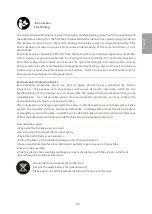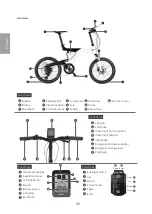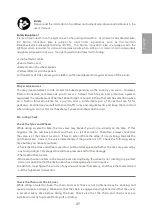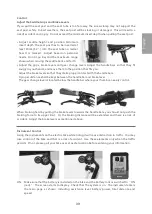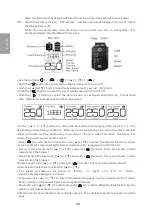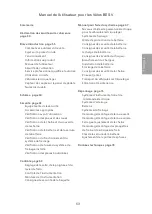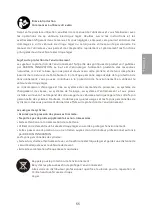
44
45
E
n
g
lis
h
E
n
g
lis
h
Battery Protection Mode
For any of the following, the battery will switch to the protection mode:
• The bike has not be used for two months.
• The battery has depleted and not charged within one week.
When the battery is in the protection mode, you need to start the battery after a complete
charging cycle.
Notes for Battery
The following instructions helps improve the longevity of battery:
• Ideally, the battery should be charged at 20°C (68°F). Please allow plenty of time for the battery
to reach this temperature before charging.
• Avoid frequent discharging completely. It is preferred to discharge locally. Li batteries are not
known for the memory effect. Loss of capacity after a period of use is common in every Li
battery. The oxidation of cores occurs as the result of long period of use and aging, and leads to
loss of capacity.
• Deep discharging of a battery will lead to irreversible damage and loss of capacity. If the battery
is expected not to be used for an extended period of time, it is advised to charge the battery to
its full capacity at least every 3 months.
Important Safety Notes for Battery Charging
• If the power cable or plug is damaged, wet or dirty, there is a risk of electric shock or even mortal
injury.
• Use only the battery charger delivered with the product.t.
• Use only dry charger, undamaged power cable and charger.
• Replace damaged power cable and charger immediately.
• Remove any possible foreign object from the charging socket, such as dusts, ice or snow before
plugging in.
• Using any battery charger other than the one delivered with the product may cause overheating
of the battery or even a risk of explosion.
• Deep discharging of battery may result in internal damage.
• There is a fire risk if the temperature of battery rises up to a dangerous level.
• Avoid deep discharging of battery while in use or storage.
• If not in use, the battery should be charged fully at least every 3 months.
• Do not expose the battery in a storage temperature lower than -20°C (-4°F) or higher than 60°C
(140°F). Please note that the internal structure of battery may be overheated to damage due to
high temperature greater than 60°C, particularly exposed to direct sunlight.
• Do not use the charger at a humid place or an ambient temperature lower than -10°C (14°F) or
higher than 40°C (104°F).
• Do not put the battery in water.
• The battery and charger are maintenance-free. Do not attempt to disassemble or modify the
battery or charger.
• Do not expose the battery to high voltage.
• It is advised not use battery with damaged casing.
• Keep the battery out of children's reach.
• If you detect that the battery becomes very hot, emits a strong odor, starts to deform or
performs in an unexpected way while in use, being charged or in storage, please stop using the
battery immediately
• The battery and charger should be placed on fire-retardant surface while charging is in
progress. If you are charging the battery while it is still mounted on the bike, make sure that the
bike is parked on an incombustible surface.
• Do not charge the battery while it is on a carpeted floor.
• Do not cover the battery or the charger while charging is in progress.
Notes for Battery Charger
The charger provided is suitable for voltage ranging from 100V to 240V. The charger does not
have to be switched to the associated voltage range, as it detects the voltage automatically.
There is no on/off switch on the charger. Make sure to unplug for energy saving if no charging is
required.
Connect the Charger
Connect the battery charger as illustrated. Connect the charger to the battery and the shining
red indicator light on the charger indicates the charging is underway. It takes approximately 5
hours to fully charge the battery. Once the battery is charged, the green indicator light on the
charger will light up. While the battery is being charged on the bike and you wish to check how
much it is charged, you may turn the system on and the instrument will show the battery level. If
you are done charging, disconnect the charger from the battery before removing the power plug
from power socket.
• There is no on/off switch on the charger. Make sure to unplug for
energy saving if no chargin is required.
• Do not pedal the bike while the battery is being charged, or there is a
risk of damaging the charging socket on the bike.
• The battery can be charged onboard or independently.
Do not move or pedal the bike while the battery is being charged
onboard.
Install the Battery
The battery is not safe if the lock cylinder of battery is not connected
correctly. The battery may fall out of the battery seat while riding and
this could produce a risk of accident.
Connect the battery charger as illustrated. Connect the charger to the
battery and the shining red indicator light on the charger indicates the
charging is underway. It takes approximately 6 hours to fully charge
the battery. Once the battery is charged, the green indicator light on
the charger will light up. While the battery is being charged on the bike
and you wish to check how much it is charged, you may turn the system
on and the instrument will show the battery level. If you are done
charging, disconnect the charger from the battery before removing the
power plug from power socket.
Store the Battery
To remove the battery, pull the clip up as shown in the picture, or the battery cannot be removed.
Always place the battery on a
foundation with the charging socket facing upwards, or the
stable
charging socket and connector plug to the battery seat may be damaged in other way.
•Deep discharging of the battery may lead to internal short-circuiting, and the battery may
become very hot, resulting in a fire hazard.
•Avoid deep discharging of battery while it is in use or storage.
•If not in use, the battery should be charged fully at least every 3 months.
•Do not carry a deeply discharged battery on the electric bike.
If the electric bike or battery is not expected to be used for an extended period of time, please
follow the following instructions:


